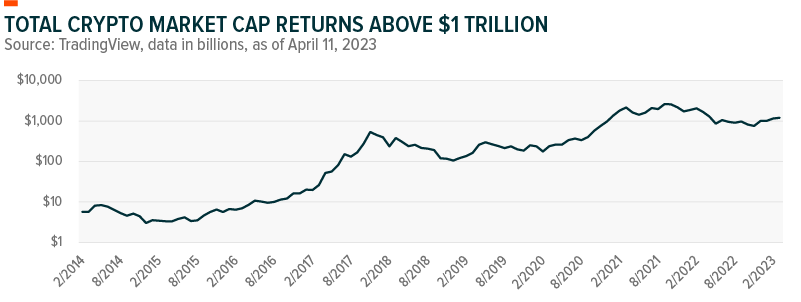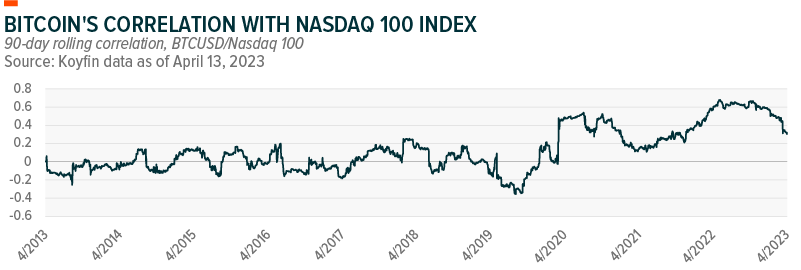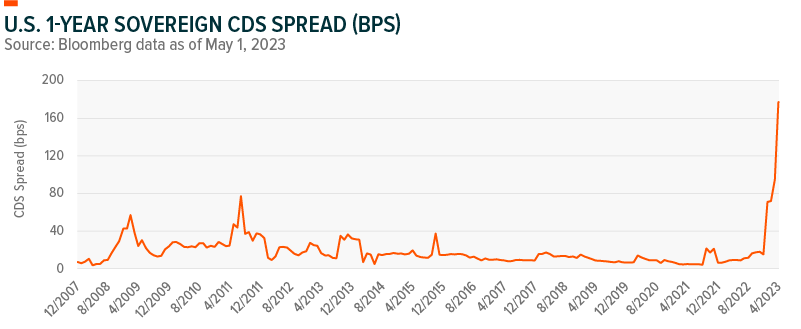Digital Assets, Blockchain and the Future of Finance – Global X ETFs

[gpt3]rewrite
Editor’s Note: Conversational Alpha® (CA) is a vehicle we use for deeper and more relatable discussions about portfolio construction. In this sense, it represents both a journey and a destination. This report is a periodic look at travel and destinations that investors may want to consider.
I’ll be honest, sometimes when I hear explanations about the details of digital assets and the various technologies behind them, the complexity makes my head spin and I tune out. What gets and holds my attention is how and why assets behave the way they do. And so far this year, Bitcoin (BTC) has my attention. After falling nearly 70% from its all-time high in November 2022, Bitcoin, the largest cryptocurrency by market capitalization, is up about 70% so far this year. That is well ahead of the Nasdaq 100 index’s 16.7% return and gold’s 8.8% return over the same period. The total crypto market capitalization briefly passed $1 trillion during the most recent rally, still well below the all-time high of $2.6 trillion in September 2021.1

Aside from the potential for fantastic returns, especially during periods of risk, cryptocurrencies are the subject of much debate and, in many ways, mystery. Whether it’s just another risky investment or a revolutionary financial instrument, crypto history will continue to unfold.
Conversation starters
- Blockchain technology is the real influencer in the digital asset space.
- Bitcoin’s correlation with traditional assets provides insight into crypto’s appeal.
- Expect governments to retain a healthy skepticism about cryptocurrencies.
- To wrap it up: Portfolio considerations.
- Moving on … Let’s chart: Treasury CDS spread flashes debt ceiling warning.
Crypto Job Numbers provide an insight into the rapid increase
Ten years ago, even five years ago, if you told someone you wanted to pursue a career in cryptocurrencies, you’d probably raise their eyebrows. Either they had no idea what you were talking about or they would think you were jumping the gun. I imagine some pretty interesting conversations between parents and their kids about the prospect of jumping into this wild west. Today, it’s a much different conversation, given the demanding nature of this field and its inertia. The sheer number of professionals working in this industry today is staggering. By 2022, approximately 82,000 professionals were working in cryptocurrencies, blockchain and related technologies. This is almost a threefold increase from 2019.2
Most of these jobs are in Web3, the open-source virtual environment that may materialize in the next generation of the consumer Internet. As powerful as Web3 can be, the architecture is what I find remarkable at this stage. I think the same about Bitcoin. Gold is often bitcoin’s pick, and their correlation tightening to 50% in March 2023 suggests that bitcoin could be the yellow metal’s digital cousin.3 But I think the blockchain technology that underpins bitcoin and cryptocurrencies and Web3 is likely to prove more influential.
Blockchain’s distributed ledger, which enables secure, transparent and tamper-proof transactions, has the potential to transform everyday life, including the way we shop, trade goods and services, even vote. Our relationship with the internet could change dramatically, given the potential to own our own digital content, which could be category killers for big data collectors. Blockchain technology has already changed business operations. For example, Amazon has a managed blockchain solution called Track and Trace for supply chain management. With it, clients can monitor their production processes end-to-end and verify authenticity.4
The financial system’s relationship with crypto will continue to evolve
Cryptocurrencies’ decentralization makes them a potential alternative to traditional currencies, which are often subject to inflation and manipulation. A more secure, democratic and fair way of sending, tracking and managing money has broad appeal, especially for participants in emerging and developing countries, where trust in the banking system can be in short supply. Of course, mistrust of banking systems is widespread in the world’s largest economies as well. The regional bank liquidity crisis is just the latest example that is intensifying the conversation about decentralized finance in certain circles.
To get a sense of changing investor sentiment about cryptocurrencies, correlations provide interesting insights. For the most part, their correlation to risk assets has been high, but recently there have been divergences, likely due to regional banking problems and certain geopolitical events. At the start of the war in Ukraine in February 2022, bitcoin’s correlation with the S&P 500 and Nasdaq 100 ticked lower, possibly driven by the belief that bitcoin can offer relative security. Correlations later increased as risk assets sold off in 2022, but bitcoin’s correlation with the Nasdaq 100 recently normalized.5

Cryptocurrencies exhibit features that could one day provide a more stable and secure form of currency than traditional fiat currencies, making them something of a government target. Do you think the US government really wants competition for its fiat currency? I don’t. But that is not to say that governments and central banks around the world reject digital assets and blockchain technology. On the contrary, they recognize that the digitization of money has the potential to change the global financial system. They also recognize that it introduces new risks into the system that must be addressed, as the March 2022 Biden administration’s regulation to ensure the responsible development of digital assets illustrates.6
The collapse of the crypto exchange FTX in November 2022 and the resulting contagion is just one example of these risks. As a result, the cryptocurrency regulatory environment is something to watch as it evolves, likely significantly from the current patchwork approach to something more defined. In particular, the risk reduction that comes with clearer regulatory regimes can benefit cryptocurrencies by encouraging greater participation.
To conclude: Portfolio considerations
How cryptocurrencies fit into investment portfolios continues to evolve. I discount the parabolic growth of cryptocurrencies in the previous years and see that they can offer some diversification potential for some investors for some periods. So far, the evidence is limited that they can improve a portfolio’s risk-adjusted return without regular rebalancing, which would create a meaningful amount of turnover.
Let’s chart: Superb CDS spread flashes Debt ceiling warning
We come down to the thread of the debt ceiling. The X date, which is when the government is no longer able to pay its bills, could come as early as June. In April, the spread for credit default swaps (CDS) peaked as demand for hedges against a US default rose. Currently, the spread is well above the July 2011 peak set during the debt ceiling crisis. As is common now, I expect political rhetoric to increase ahead of a possible deal, but the longer uncertainty persists, the more volatile markets are likely to become. Even the post-deal period looks volatile, as I expect a huge amount of Treasury issuance to cause market dislocation.

[gpt3]

























